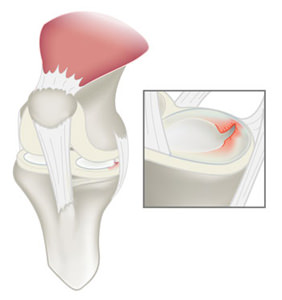
One of the most common knee injuries, meniscal injuries occur when the knee’s shock absorbers tear. The resulting pain and swelling can keep you out of commission, and the injury doesn’t always resolve on its own. Our knee specialists care for meniscal injuries at all Summit Orthopedics clinics and orthopedic urgent care locations in Minneapolis/St. Paul and Western Wisconsin.
The Cause of Meniscal Injuries
Your femur and tibia bones meet to form the knee joint. Two rubbery, C-shaped discs rest between these bones, preventing the bones from rubbing against each other. Each of these discs is called a meniscus.
Most meniscal injuries are meniscus tears, which normally occur when you make a quick twist or turn with your foot planted and your knee bent.
Athletes often experience meniscus injuries, but anyone can experience them, especially as you age and your knee joints weaken. Events that may cause a torn meniscus include:
- Crashing into another player while playing contact sports
- Kneeling down
- Pivoting or cutting sharply during a game or practice
- Twisting awkwardly when standing up
Symptoms of a Meniscus Tear
Meniscus tears can cause a variety of symptoms. If you have a torn meniscus, you may experience:
- A catching or locking sensation in the knee
- Difficulty squatting down
- Feeling that your knee is giving way
- Limited range of motion in the knee
- Pain and swelling
- Stiffness
With a torn meniscus, you may feel pain when you twist or rotate your knee. Many people continue walking with meniscal injuries and ignore the problem. Some athletes even keep playing sports with an injured knee.
However, not treating a meniscus tear can cause serious problems in the future. The inner part of your meniscus has a naturally low blood supply, so an injury to this part may never heal. Over time, if left untreated, your injured knee is at increased risk for developing arthritis.
Diagnosing Your Meniscal Injury
A torn meniscus is often diagnosed through a physical examination at your local orthopedic urgent care location. An orthopedic surgeon or sports medicine specialist will ask about your symptoms and what you were doing when the injury occurred. Then, your provider will examine your knee closely and may order imaging tests including:
Imaging tests may help confirm your diagnosis. Tests you may undergo include:
- MRI to view the location and extent of the injury
- X-ray to determine the presence of arthritis or injury in the knee
Treatment for a Meniscus Tear
Treating meniscal injuries depends on several factors. Your team will choose a treatment based on your age and activity level, as well as the severity and location of your injury.
Based on this information, you may benefit from nonsurgical treatment, surgery or both.
Conservative Treatment Options for a Torn Meniscus
Nonsurgical treatment options include:
- Inserts. Arch supports or other shoe inserts help distribute your weight and reduce stress on your knee.
- Medication. Over-the-counter nonsteroidal anti-inflammatory drugs (NSAIDs) can reduce pain and swelling.
- Physical therapy. A physical therapist can teach you exercises to strengthen muscles, support the knee joint, and protect against further injury.
- Platelet-rich plasma (PRP) injections. Known as Orthobiologics, PRPs use a high concentration of platelets from your blood to speed healing.
- Rest, ice, compress and elevate (RICE) the injured knee. The RICE method is often the first treatment for a torn meniscus.
Repairing Meniscal Injuries with Surgery
When conservative treatment doesn’t correct meniscal injuries, surgery may be necessary. Arthroscopy is one of the most common techniques used for meniscus surgery.
During an arthroscopic procedure, the surgeon guides a pencil-thin device called an arthroscope through a small incision in your knee. A tiny light and camera at the end of the scope show the inside of your knee. The surgeon then uses tiny tools to fix your knee problem.
Surgical options include:
- Meniscus repair. The surgeon sews together the torn parts of the meniscus.
- Partial meniscectomy. The surgeon removes damaged meniscus tissue.
Recovering from Your Injury
Appropriate treatment can help you regain full function of your knee. To make sure you fully recover, follow your surgeon’s advice. They may recommend that you:
- Avoid putting all your weight on the knee until the pain goes away.
- Use crutches or other mobility aids while recovering.
- Work with a physical therapist to help strengthen the muscles in and around your knee.
The amount of time needed to recover depends on your injury. A minor tear can improve within a few weeks, even if you have surgery. Partial meniscectomy needs as few as three weeks to heal fully. Recovery after meniscus repair, on the other hand, can take up to six months.
No matter how long recovery takes, contact your Summit Orthopedics care team if you experience the following:
- Fever of 100˚F or higher after surgery
- Persistent bleeding at the surgical site
- Symptoms that worsen instead of improve
Injured your knee? The experts at Summit Orthopedics can help you manage a meniscus injury. Visit one of our six convenient Summit’s Orthopedic Urgent Care locations or make an appointment today
